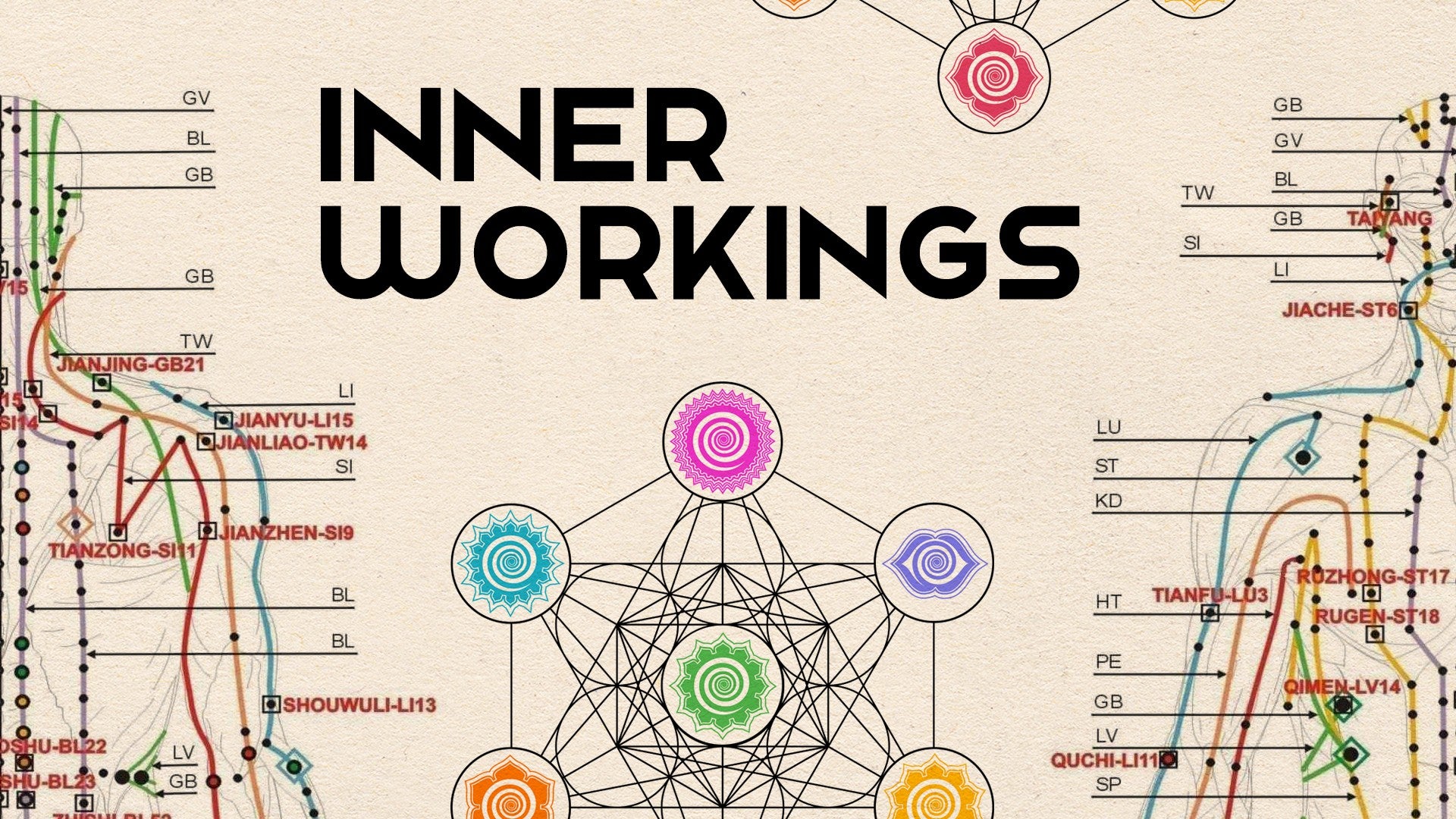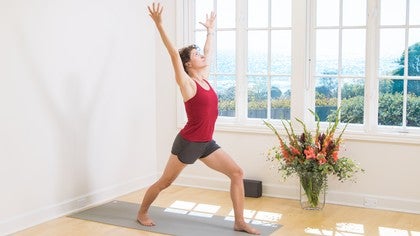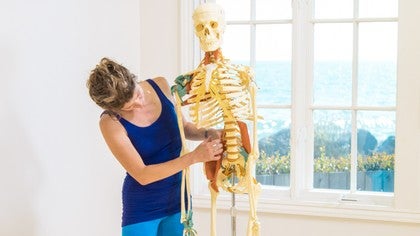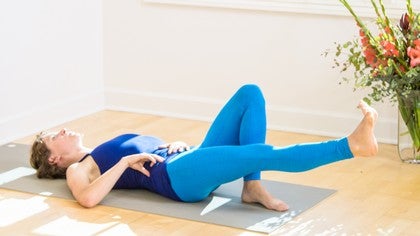Description
About This Video
Transcript
Read Full Transcript
Hi. This practice is designed to help us go deep into the pelvic bowl, to the center of the pelvic bowl, to what the yogis refer to as Muladhara chakra. I also call it your first energy center. It's a place that you can feel, and that's our goal here, is to help you feel it. Your energy centers are not muscles. You can't squeeze them. We can't take a picture of them. They're not going to show up on an MRI. But you can feel them. Often, especially at the beginning of working with the subtle body, the sensation is not as sure, as present to the nervous system, as the grosser layers of tissue are. So, my encouragement is to allow for uncertainty in the practice. I'll tell you how to move and what to squeeze. And if you're not sure that you're feeling what I'm describing, that's totally okay. The sensation will surprise you. So, the first thing we're going to do is take the block and put it between the thighs, just like this. You want to have your ankles roughly underneath your thigh bones. The block is slightly too wide for me. It might be a little too narrow for some people. It's okay. And then you're going to bend the knees. So, you're coming roughly into Utkatasana. And all we're going to do is roll the block back behind. Push it backward. And then we're going to roll it forward. Roll it forward. Back. Forward. Back. Forward. Now, while you're doing this, the actual subtle body energy center in the body remains pretty steady. But the body is moving toward it from the back and toward it from the front. And you can coordinate that with the breath. So, the inhalation can push the block back behind you. And the exhalation can push the block forward. Inhale. Exhale.
Now, the next thing I want to do is see if you can find neutral. So, now that you've been back and forth with the block, where does it feel like you're moving it backward and you're also moving it forward? Feel around for it. Can you do a little bit of both at once? And then my suggestion is that while you're trying to do both at once, you might be working really hard and you could probably take it down a notch. If you need to take a break at any time while we're doing this, feel free. The next thing we're going to try to do is lift the block all together bilaterally toward the floor of the pelvis. So, with the balanced action of the thighs, the internal and external rotation of the thighs balanced, you're just going to try to lift it up toward you. And you'll feel the pelvic floor come into play, the squeeze this way. And the combination of those things, of the squeeze in from front and back and the lift of the pelvic floor will contract the whole pelvic cylinder concentrically. All of that tissue is going to draw into itself. And the pelvic cylinder all the way around will get closer to the centre. It's like you're giving yourself a hug. Then you're going to stand up, push into the feet, stand up and release the block as though you would drop it. That's the release of all of the tissue and then the eccentric contraction, if you keep going beyond release, the eccentric contraction of the tissue in the pelvic cylinder so that it opens around the centre, you're creating space. And you might even feel it kind of like a vacuum in there. And we can do that a couple more times. So the knees bend and you lift it up and then you push and release it. The knees bend and you gather the block in toward yourself, neither forward or backward, but up. And then the legs straighten and it's a release. And you let it go. The last thing we're going to do with the block in is that same motion amplified. And we're going to add the breath. So when you inhale, it's this big release. You breathe in, you release and you come into extension. Every joint is open. When you exhale, you're lifting the block in toward the floor of the pelvis, curling the face down toward the knees and reaching the hands dynamically back. To help you keep the collection of the tissue on all sides, you're also going to imagine that you're pulling the sitting bones down toward the heels or toward the backs of the knees. So we inhale here and then we exhale all the way down. And inhale, the block descends, the pelvic cylinder releases, there's all this space in the in breath. And we exhale again. So you can see even with my hands here, I'm enacting the opening of the cylinder. You might even be able to feel in the jaw and the roof of the mouth. And opening in the in breath. So you can take the block out. This next piece is similar. The legs are going to be wide here. It's kind of a horse stance position. So the toes can point out at the same angle that your knees point out or the toes can be turned in a little bit. Finding support in this posture, in the horse stance posture, is all about being able to root through the feet and carry the weight of the body through the pelvic centre and into the legs and then also feeling the rebound of that and having the energy in the floor come back up through the arches of the feet, through the centre of the knee and into the pelvic centre where it will let you feel really lifted and supported. So we're going to bring our hands for support here and you really want to have your arms locked, your resting so that the belly can be really soft because we want to be able to play with that softness in the pelvic cylinder that happens with the in breath. With the out breath, we're drawing energy from the soles of the feet all the way up into the pelvic floor. With the in breath, we're releasing it back down. Just like the block, up, down. So the in breath comes in and you've got kind of your thumbs as like reminders. This is the line where the breath is moving. The inhalation comes down from the pelvic centre through the inner thighs. The inner thigh tissue here is continuous with the sides of the pelvic cylinder. So you're travelling from the centre into the sides of the pelvic cylinder and down. Inhale. The belly gets really soft. Melty, melty. And when you exhale, you're going to push a little extra in the feet and draw all the way up. Inhale. Exhale. Inhale. Exhale. Now you may notice as you investigate that practice that it's easier for you to close the front of the pelvic cylinder or the back of the pelvic cylinder. Then you get the opportunity to play with how the feet are connected to the cylinder. So if the front of the bowl feels like it's closing, you're probably holding weight more in the front of the foot. And if the back of the pelvic cylinder feels like it's closing, you're probably holding more weight in the heel. And you can play with that all the way down here or just in your horse stance, feeling for the support of the feet inside the pelvis. Okay. So we're going to move on. We'll use the wall to do a posture called Ardha Uttanasana. The hands are on the wall. The hand is going to be higher than the shoulder and the shoulder is going to be higher than the hip. But you're going to back away from the wall enough that the hip socket can be over the ankle. And that might take a little bit of wiggling and I'll wait for you. So in this position, what I'd like to do is pretend like we have the block. And if pretending like we have the block doesn't work for you, get your block back out and use it so that you can feel the roll behind and the roll forward. Because I want you to be able to feel how that energy moves up into the shoulders and the hands. So we've got the hands. The hands are higher than the shoulders. The shoulders are higher than the hips, just by a little. And the ankles are underneath the hip sockets and I'm going to bend the knees a little bit and roll the block behind me.
And then I'm going to roll it forward. Now I'm exaggerating so that you can see the changes in my body. It does not need to be this extreme and really the ends of this movement are kind of beyond balance joint range for me. So really, there is no block. And your experience here might be very small. You can close the front of the pelvic cylinder down a little tighter and open the back of the pelvic cylinder up a little more. And then you can close the back of the pelvic cylinder down a little tighter and you can open up the front of the pelvic cylinder a little bit more. And that tissue, you're actually passing it from the back to the front and from the front to the back. You're just handing it around. You can also play with lifting up the imaginary block and concentrating all of the tissue toward the pelvic centre. And then releasing the imaginary block and opening all of the tissue away from the pelvic centre. I want to play with all those same movements with the legs further apart. A lot of times when there's some stretch in the adductors, it helps us feel deeper into the pelvic cylinder because of that attachment. So for some of us, it's going to make the most sense to have the hands on the wall. When we come down too deep here, you'll lose proprioception. Overstretching really limits your ability to feel what's happening inside your body. So my suggestion is that unless it's quite easy to get your hands to the floor, have your hands on the wall. Or if you want to experiment with having the hands on the floor, go there and make sure that you can feel as well as you could feel before. So again, you're just going to back away from the wall enough that the hip socket can be over the ankle when you're drawn back. And the shoulder can still be higher than the waist. And then you can play with drawing energy up from the feet, toward the floor of the pelvis, and into the center, releasing and extending from the center toward the soles of the feet. You might be able to direct some energy when you draw up from the soles of the feet into the pelvic center. You might be able to turn that energy and draw it up toward the crown of the head from the pelvic cylinder. You might be able to push back into the cylinder and into the pelvic center from the hands. All just places to play. Let's start seeing if we can play with passing energy from one leg to another through the center. So you're just going to come and sit in Utkatasana here with the sacrum against the wall just to make balance easier. You can always do it this way, if you like. It's kind of a good idea to make the balance easier because I'm going to ask you to redirect how the weight is distributed from one leg to another. So first you pick this foot up, right foot, and then you cross the right ankle over the left thigh. And for most of us, the weight will sweep pretty fast into the outer left hip to counterbalance the opening of the right thigh. And I want to come with the breath and reconnect from the pelvic center into the left inner thigh. So from the pelvic center, in breath down to the sole of the foot, and from the sole of the foot, out breath up from the left sole of the foot, from the standing sole of the foot, up into the pelvic center. You're rerouting. And you can feel once you've done it, if your balance is easier. So let's do the other side. Cross the left ankle over the right thigh. You want to keep an eye on the edge of the foot here so that you don't end up looking at the sole of the foot for the health of the knee. And in this knee as well, just the work with the center will help put this knee in its healthiest position over the ankle. This is where we're starting to get risky when the right knee moves beyond the right ankle a lot because of how much weight is in the outer right hip. So we want to keep that directed through the center. From the pelvic center, in breath down, and out breath up. In breath down the standing leg, from the pelvic center, through the right side of the cylinder, into the right inner thigh, into the right foot, and back up. Okay. Virabhadrasana. Virabhadrasana one. We'll do the left foot first. So the left foot's going to stay forward and you're going to step the right foot back. In Virabhadrasana one, I like to have the right heel to the right of the left heel. Again, because if we end up in too charged of a position, if there's too much torque, it's going to be hard to feel into the center. So even if this is a less dynamic posture than you're used to, experiment with how well you can feel into your center if you give yourself a little bit more space to work. So Virabhadrasana one, the heart is looking forward and the arms are up. And then we're going to feel into both feet. So you can push down through both feet and soften the whole cylinder. And just like we did before, we can open the arms to help us feel the opening of the pelvic cylinder, the space around the center. And then with the exhalation, you can draw up from the feet and give yourself a hug. Okay. Step up. Let's do the other one. So right foot forward, left foot back. And we're going to bend the right knee forward. Again, if the outer hip is pulling too much, then the right knee will wander wide of the right ankle. Or if the psoas is drawn too deep, then the knee will come in. And we're hoping to find balance in the joints via balance in the center, but it's still worthwhile to check in on your external alignment and make sure you're staying safe. So the arms go up and you can inhale and soften and dive down and exhale coming into center. Inhale. Exhale. And step up. So I want to do that again. I want to do Virabhadrasana I all over again.
And this time instead of feeling for the general expansion and contraction around the center, I want to feel for the ability to pass energy from one foot to the other. Coming back to Virabhadrasana I, left foot forward, left knee bends, right leg is straight. I want to feel for support from the front foot and lengthening into the back leg, rooting downward in the back leg. So I want to find the exhalation rising from the foot and feeding the pelvic center and the inhalation releasing into the back foot. Again, as I exhale, I want to feel lift and support from the front leg. And as I inhale, I want to feel release and softness into the back foot. I'm going to do that one more time with you. Inhaling down and exhaling up. And we'll step up. Now I want to say here that if your breath feels like it works the other way, it probably does. I can do this both ways. It works both ways. Your feeling of eccentric contraction of expansion and lengthening might be connected to your outbreath. My feeling of concentration and knitting is often linked to my outbreath. It's up to you. You can play with it. Inhale the arms up. What we're feeling for, regardless of how you use the breath, is how to source the pelvis from the front leg and release the center toward the back leg. One more breath. And inhale, step up. So we're going to do Virabhadasana 2. In my body, the principles of the front leg and the back leg feel almost opposite there. So the left foot's forward. The right foot steps back. This time the pelvis is open and the heart is open to the space between the feet. And this time the arch of the back foot lines up roughly with the heel of the front foot. If you are feeling a loss of proprioception, the way that you could offer yourself more support is by moving the feet closer together. If the legs are too far apart, you may not be able to feel well into your more subtle body. So the knee is opening over the ankle and the arms are wide. And this time I want to bring the energy up the back leg into the center through the inner thigh, through the right side of the pelvic cylinder into the center. And I want to release through the left side of the pelvic cylinder through the left inner thigh into the left foot. And I'm going to do that by exhaling up and inhaling out. Okay, step up. Let's do a fear of addressing the two on the second side. So the right foot's forward. The left foot steps back. The pelvis is open between the legs. The arms open wide. And I'm going to draw energy up the left inner thigh from the left arch into the pelvic center and release it out the right thigh toward the right sole of the foot. And again, you can use your in-breath or your out-breath, but make a whole breath cycle out of passing the energy across the pelvic center through the pelvic center and into the front leg. And then we'll step up. So let's do Trikonasana, our last standing pose, kind of a home pose for me. I come back to Trikonasana again and again to check what the other work has done, what the feeling of the practice is in my body and especially in the center of my body. So the heel lines up with the arch. The left foot is forward. And we're going to glide down. Again, if the hand comes too deep, you might lose the delicate sense of self in here. So feel for that. I'm going to draw up the inside of the back leg into the pelvic center and down the inside of the front leg into the pelvic center. Up and down. Exhale to look down. Inhale, come up and we'll do the other side. Triangle pose and reach. Now, actually, before we go in, I want to say that if you're not sure about this whole passing the energy back and forth thing, if it's hard to feel the center itself and crossing the center feels complicated or the breath directions feel complicated, you could use the breath very simply exhaling to concentrate around the center and hug. Inhaling to make space and open. So the breath comes up both legs and down both legs. That way you just get a nice familiar squeeze.
Right foot forward. Left foot back. Left arm comes up. So if I do that with you, then I push down in the feet and the energy comes up with the exhalation. And then I inhale and exhale. Look down at the foot. Exhale. Inhale, come up. Step up. Let's have a pause in Tadasana so you can feel the feet. Feel the energy in the knees, in the ankles, in the hip sockets, and especially in the pelvic center and in the pelvic cylinder. Standing here if you're aware of some kind of residual stress somewhere, a place where you maybe worked a little bit harder than you needed to or than was totally appropriate, in order to find something that's more subtle, that's more out of reach. It happens to me all the time. It's a really nice thing to stand and give notice to those tissues in the hopes that with more cellular awareness in those places, you can work a little less hard. Okay. So let's come down to squat. So I've grabbed a bolster and a blanket, and now I have two blocks. Those are the props we're going to need to make the final relaxation pose that we're going to do today, which is supported Baddha Konasana with the feet together, lying back. You don't have to have these exact props to make yourself a really comfortable and functional supported Baddha Konasana. You could use a collection of pillows from your bed or your couch. You could use stacks of books for your two blocks. You're not being dynamic on the props, so you just have to feel comfortable. Right now, I'm going to use my blanket to demonstrate a way to modify your squat. If the heels don't come all the way down to the ground when you squat and you find yourself kind of perching, then the blanket can be made into a support for your heels so that you can bear weight back there. And that will encourage the flexibility in the ankles and the length in the backs of the legs to allow you to gradually make your way down. If squatting is really not functional for your knees, on the other hand, I recommend you find something to sit on. So you can use a block or even a chair and still offer a chance for the ankles to develop more flexibility by drawing them in close. So we're squatting. Here. And this is an opportunity to interact with the gentle squeezing of the pelvic center without needing to be really dynamic about it. You can just feel in there and maybe once you do it, and then the next time you do it at 50% of that. And the next time you do it at 50% of that until the sensation is almost disappearing. Okay. Let's come to Cat-Cow. Continuing to have these really gentle interactions at Mulidara Chakra, you can swish the tail side to side. This is the time when I say that this whole practice is a great practice if you're pregnant. Getting in touch with the pelvic cylinder and with your root chakra is a great way to support the pelvic tissues while you're pregnant and also to help you in learning how to relax them for birth. So you just swish side to side. And you can do your exhalation into your cat pose and your inhalation into your cow pose. Just keeping the awareness at the pelvic center as you glide around left and right, sliding weight from one knee to the other, and then maybe even rolling all the way around. Imagining that what you're rolling around, even though the whole spine is moving, imagining that what you're rolling around is Mulidara Chakra in the center of the pelvic cylinder. Nice and gentle. And then finally, we're going to come down to Supta Baddha Konasana. This is the chosen pose for final relaxation here because it really offers the opportunity to irrigate the pelvic floor tissues and the tissues inside the pelvic cylinder. Everything in this pose is higher than the pelvic cylinder, so it's receiving lots of nourishing fluids. If you don't have the props you want to have or you just try and you're not really getting comfortable with this, you can always just put your legs up the wall or you can choose constructive rest position. So I'll show you how I set up. This blanket is going to provide kind of like a lift at the top of the bolster for my head and I can make it different heights depending on what kind of lift I want. And these blocks are for me to rest my knees on so that my inner thighs can really relax and not have to support the knees when my legs are apart. The bolster is for the whole of my spine. Really tall people might find that the length of the spine is hard to support on one bolster and you might want to build up your back end a little bit more. And then the bolster comes right to my sacrum. The soles of the feet are together and the knees are supported on blocks. They could even be this high. If you turn them on their side, just the point in the little notch of the knee so you don't have a rigid edge. And you're going to try to line up the line of the soles of the feet meeting with the pubic symphysis. And lie back. So we're just going to rest here. In the first minute or so, if you feel some nagging lack of support somewhere, please do kind of wiggle around and try to fix it. And then after that, we'll try to just be still together. After so much work in and around the pelvic cylinder and Muladhara Chakra, you may remain quite aware of the way that the breath touches or relates to that place in the body or the way that place relates to the rest of the body. But it isn't necessary. Your work here is done. The more fully you can feel the support of the floor and the props, the more fully the cells will be able to do their own work, nourishing and supporting you.
Thank you very much. If you have the time here to stay in this position or to come all the way down into vasana for another five minutes or so, I encourage you to do that. If your practice time is over, you can bring your hands to the outside edges of the thighs and help the knees come together. Pause for a moment, allowing the inner thighs to drain back into the deep pelvis. And then help yourself come over off the bolster and up to sit.
Feeling you feel the weight come down through the sitting bones, you feel the balance of weight between the back of the cylinder and the front of the cylinder. And the essentially unknowable muladhara chakra, which is still completely yours, feeding you and rooting you all the time. Bring the hands together. We go in to meet each other, namaste.
Inner Workings: Devon Riley
Comments
You need to be a subscriber to post a comment.
Please Log In or Create an Account to start your free trial.













